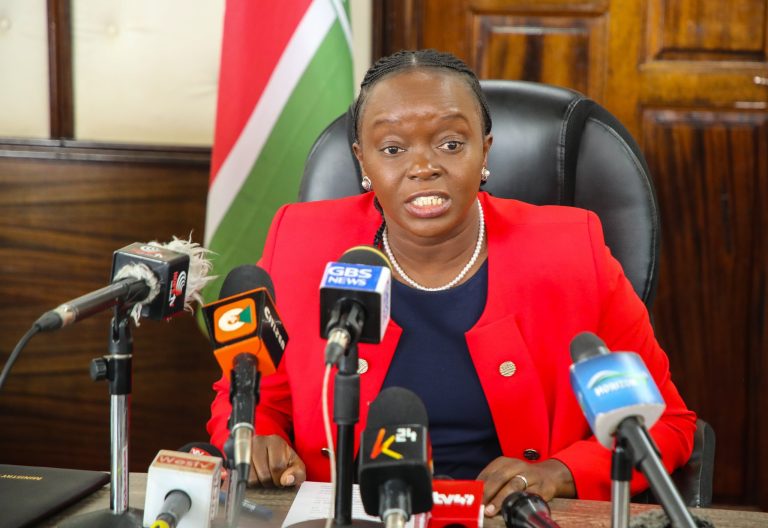My struggle with mysterious blood vessel disease

After two decades of missed diagnoses, Lilian Wangari was finally found to have vasculitis, a complex illness of the inflammation of the arteries with unknown causes and symptoms that make it hard to pin down. She shares her story.
Milliam Murigi @millymur1
It started with rough skin on her legs, then cracked skin, which lasted for some time.
The condition didn’t respond to all medication given by doctors as well as different types of oils and cream applied.
This was little Lilian Wangari’s Kibunja skin 31 years ago. She was barely two weeks old when all these symptoms started showing. However, no doctor could tell what was wrong with her.
Countless appointments with different medical specialists resulted in no definite diagnosis.
Various conditions, from eczema, hormonal imbalance, and even pregnancy were considered as she grew up. Not knowing what to do, some doctors ended up just prescribing painkillers for her.
She describes her skin at one point as looking close to that of a reptile, and as she grew older the symptoms kept changing.
It also took her a little longer to start walking as a child, but eventually she did.
All this used to confuse Lilian’s mother a lot. “At one point when I was 10 years old, my mum took me to this doctor who told me to take a pregnancy test, because he was sure the symptoms were pregnancy-related.
We walked out of that office and we never took the test or went back. We just went home and called it a day,” she recounts.
Despite all these, when she attained school-going age, she was taken to school.
Though it was a little bit challenging at times, nothing could deter her love for education. She wanted to succeed in life and become a doctor. But when worse came to worst, she would stay at home.
“In Class Three, I only went to school for two terms because my body was too weak and could not bear the pressures of daily life.
All I could do was eat and sleep. It’s a miracle and I am thankful that I managed to study all the way to a master’s degree level,” she narrates.
Then something strange happened. When she turned nine years old, she started having flare ups on her legs characterised by redness or flush on her skin.
Flare ups are the second reaction in the triple response to injury that happens due to dilatation of the arteriole. When this occurs on your legs, they are called leg flares.
These were the clearest symptoms of Leukocytoclasytic Vasculitis, a condition that was finally diagnosed10 years later after one doctor volunteered to research her ailment.
“I was 19 when I finally got a diagnosis, but not without several tests that turned negative.
We are glad that the doctor was determined to know what was wrong with me, and he finally cracked the code,” she says.
Small blood vessels
Leukocytoclastic vasculitis (LCV), also known as hypersensitivity vasculitis and hypersensitivity angiitis is typically an acute condition that causes inflammation of small blood vessels in the skin.
It’s marked by inflammation and redness of the skin that occurs when you come into contact with a reactive substance.
For her case, gluten products, such as legumes and stress are the major triggers.
Treatment focuses on controlling the inflammation and managing any underlying conditions that may be triggering the vasculitis.
“Since I discovered the products my body reacts to, I stopped using them. My diet nowadays is mostly meats, vegetables and fruits.
For flour-based foods, I only do anti-inflammatory flours, such as cassava, pumpkin and tiger nut flour, and no artificial sugars.
I always try to keep my stress levels to the minimum at all times,” she adds.
Jane Ndung’u, a healthcare professional and nurse, LCV is a pathologic diagnosis, not a disease.
It usually presents as an acute process that resolves spontaneously in about 90 per cent of patients within several weeks or months.
But approximately 10 per cent will go on to have a more chronic course. “This is a rare condition caused by immune cells attacking blood vessel cells by mistake.
There are so many triggers to this immune reaction. Some people are also more exposed, because of their genetic makeup,” says Jane.
Though having vasculitis is a life-changing experience that affects every aspect of life, to Lillian, getting to know what she was dealing with made her life easier.
She also got to do a lot of research to know what she should do, or not to manage the condition.
Along the journey, she has discovered the magic of an anti-inflammatory diet and that has been a game-changer for her since this condition has no cure.
She is also into supplements that make management of the ailment easier. Every day, she takes calcium, vitamin B12, magnesium glycinate, and alfalfa chlorophyll or wheatgrass juice supplements.
She grows her wheatgrass for juicing, as well as most of her foods, fruit, and vegetables.
She gets most of her supplements from K2U Africa, a health and wellness company, which has also played a huge role in improving her health.
“There is no permanent treatment or cure for autoimmune disorders, just management plans.
One thing I can say for sure is that anti-inflammatory food is medicine. It has helped me start healing my body and tapper down on my medication.
Generally, I live a better life, because I mind about what I put in my mouth,” adds Lilian.
However, Jane reveals that the best treatment is a steroid known as prednisolone. Other drugs, include methotrexate, azathioprine, cyclophosphamide, tocilizumab or rituximab.
Once diagnosed, drugs may be given by mouth or vein depending on the type and severity.
Usually, medication starts with a higher dose then the dose keeps reducing.
The best thing about this condition, Jane says is that some types go away on their own.
For example, if the cause is an allergic reaction to a certain drug, it may go away on its own within days.
“I started with six milligrammes of a steroid called yescort per day, but with time, I have managed to taper down to only three milligrammes a day, which literary feels like winning an Oscar.
I hope to go on remission soon and only do management using an anti-inflammatory diet and supplements,” she sighs.
Jane says that though it is now easier to diagnose vasculitis compared to the past, failure to seek healthcare services in good time and non-adherence to medication can result in severe forms, and damage to the body organs, such as the heart, lungs and kidneys.
Other parts of the body that maybe affected by vasculities, include the nose, eyes, digestive and nervous system and joints, hence causing complications, such as loss of limbs and blindness.
Early detection and treatment is the best way to prevent this condition from impacting the quality of life.
In some cases, organs in the body may be damaged, especially if they do not receive enough nutrient and oxygen, and in worst cases, death may occur.
“The use of combined management of the condition by specialists, treatment becomes holistic and with good outcome,” adds jane.
Frequent check-ups with the physicians, eating anti-inflammatory foods such as fruits, vegetables and whole grains, medication adherence, doing mild exercises, and sometimes skipping activities like walking and bathing can be helpful.
Though Lilian considers herself lucky, because she can continue with her work, she says the condition left her with physical and emotional scars.
At one point, she could not wear short dresses, because they would expose the scars on her legs.
However, things have changed over time as she learns to accept herself, and now she can put on short dresses and shorts. She has even embarked on a mission to create awareness about the condition.
Also, there’s the challenge of preparing her body for pregnancy. With this, she always feels like she is preparing to go to war, and her greatest fear is her children inheriting the disorder from her.
“I have made peace with my scars and the rest of the world will have to adjust.
I have also started a Facebook page, Autoimmune Support Kenya to bring together people with autoimmune diseases and provide a safe place for them to meet and share their experiences.
I aim to support where I can, more so mental support, because sometimes it takes a toll on patients mentally, physically and financially,” she says.
No statistics on condition
However, according to Jane, only four types of vasculitis from the known 20 types are hereditary.
The rest are caused by other factors, such as infections and reactions to different products.
The hereditary ones are Kawasaki, Behcet’s, Granulomatosis and polyangiitis types.
Her advice to persons living with rare conditions is to strictly stick to gluten-free diets.
This is, because almost all rare conditions have everything to do with inflammation and a gluten-full diet triggers inflammation.
She says lack of statistics on people suffering from the condition makes them invisible and pleads to the government to create more awareness of rare disorders.
She also emphasises on the need to train more doctors who specialise in such conditions.








